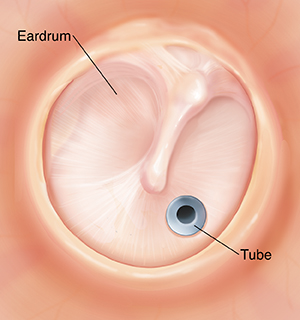Tympanostomy (Ear Tube)
Tympanostomy (Ear Tube)

Before the procedure
Unless you’re told otherwise, stop giving your child food and drink at least 4 hours before the scheduled arrival time. Verify the exact time with the surgeon's office.
Your child will have a physical exam, including taking his or her temperature to rule out any active infection. This could require postponing surgery.
When you arrive, your child may be given medicine (a mild sedative) to help him or her relax.
You—as parent or legal guardian—will be given a consent form to sign after the healthcare provider has discussed the procedure with you.
During the procedure
Using an operating microscope and special surgical instruments, the surgeon will make a small slit in the eardrum (tympanotomy).
The surgeon will use a suction tube to gently remove fluid buildup through the slit in the eardrum. In some cases, a fluid sample may be sent to a lab to see if the infection is still active.
The surgeon will put a tiny tube into the same slit in the eardrum (tympanostomy). Once in position, the shape of the tube helps keep it in place. Tubes can be made of plastic or metal, and they vary slightly in size and shape.
After the procedure
Within a half-hour, your child will wake up. When you join your child, don’t be alarmed if he or she is upset. Anesthesia may reduce self-control. This causes some children to cry or scream.
Once your child is calm enough to sit up and drink fluids, he or she can go home.
At home, be sure to give your child any eardrops or other medicine as directed by the healthcare provider.
Go to all follow-up appointments as scheduled.
When to call your child's healthcare provider
Call your healthcare provider if your otherwise healthy child has any of the signs or symptoms described below:
The ear bleeds heavily or keeps bleeding after the first 48 hours.
Sticky or discolored fluid drains out of the ear after the first 48 hours.
Fever (see Fever and children, below)
Your child has had a seizure caused by the fever
You child is dizzy, confused, extremely drowsy, or has a change in mental state.
Fever and children
Always use a digital thermometer to check your child’s temperature. Never use a mercury thermometer.
For infants and toddlers, be sure to use a rectal thermometer correctly. A rectal thermometer may accidentally poke a hole in (perforate) the rectum. It may also pass on germs from the stool. Always follow the product maker’s directions for proper use. If you don’t feel comfortable taking a rectal temperature, use another method. When you talk to your child’s healthcare provider, tell him or her which method you used to take your child’s temperature.
Here are guidelines for fever temperature. Ear temperatures aren’t accurate before 6 months of age. Don’t take an oral temperature until your child is at least 4 years old.
Infant under 3 months old:
Ask your child’s healthcare provider how you should take the temperature.
Rectal or forehead (temporal artery) temperature of 100.4°F (38°C) or higher, or as directed by the provider
Armpit temperature of 99°F (37.2°C) or higher, or as directed by the provider
Child age 3 to 36 months:
Rectal, forehead (temporal artery), or ear temperature of 102°F (38.9°C) or higher, or as directed by the provider
Armpit temperature of 101°F (38.3°C) or higher, or as directed by the provider
Child of any age:
Repeated temperature of 104°F (40°C) or higher, or as directed by the provider
Fever that lasts more than 24 hours in a child under 2 years old. Or a fever that lasts for 3 days in a child 2 years or older.
Updated:
October 07, 2017
Sources:
Clinical Practice Guideline: Tympanostomy Tubes in Children. Otolaryngology-Head and Neck Surgery. Rosenfeld R. Otolaryngology–Head and Neck Surgery. 2013;149(1):s1-s35., Overview of tympanostomy tube placement, postoperative care, and complications in children. UpToDate
Reviewed By:
Fetterman, Anne, RN, BSN,Image reviewed by StayWell medical illustration team.,Kacker, Ashutosh, MD,Turley, Ray, BSN, MSN